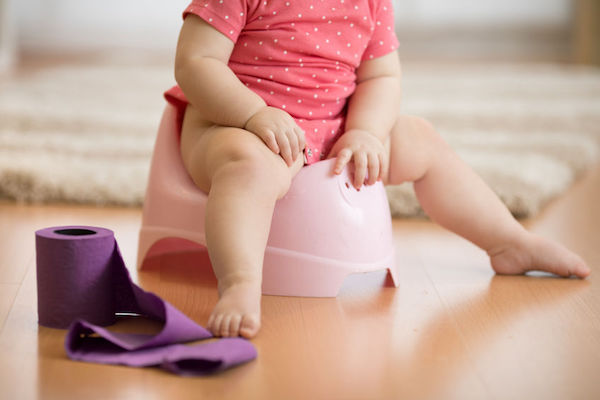If you don’t already have a potty at home, a good place to begin this process is to go shopping with your little one. Your child will love the independence of choosing his or her own potty; the same goes for choosing “big-girl” or “big-boy” underwear. Next up, place the potty beside the toilet and encourage your child to sit on it when you go to the loo, for a bit before they get into the bath, and eventually at regular intervals throughout the day. This will familiarise them with the use of the potty in the midst of their daily routine.

Setting little ones up for good bowel habits for life
“Once your child has made the connection between the sensation and the function of urinating – perhaps while running in the garden – be sure to place her on the potty two to three times a day,” says clinic manager at Bowwood Baby Clinic, Cindy Homewood, a registered nurse and midwife. “You could call it story time, or just have a chat about the day. Reading, especially, will help your youngster to sit a while longer; two-year-olds have notoriously short attention spans. What’s important is getting comfortable with sitting in the right position for everything to be released, whether they produce anything or not.”
Homewood adds that if they get used to sitting on the potty every morning before playschool and preschool, it will help promote healthy bowel habits into adulthood. Many toddlers are, however, afraid of the flushing toilet, or even of water gurgling down the drain after the plug is let out of the bath. So be reassuring about these fears, and move the potty, if necessary, to where they are happy to sit a while. At night, the journey to the potty should be well lit.
Considering skipping the potty stage?
“Some parents decide they aren’t going to do the potty stage, not realising how important it is,” advises Homewood. “If you are skipping the potty stage and going straight to the toilet, be sure there’s always a toddler seat that fits on top of the toilet - so they can’t fall in - and a step underneath it for their feet so they are best positioned “to go”. I also tell parents to put a few sheets of toilet paper on the water, because your child could be scared off by it splashing up on them, creating a setback,” she adds.
With all the above to consider, parents may find it easier just to carry the potty around with their little one!
Potential triggers for potty regression
Have you just moved house? Are you returning to work after being at home? Has your child started a new school? Or do they have a newborn sibling to adjust to? These changes are cause for delaying potty training, until your child is more relaxed and a solid routine has resumed. “In fact, if there’s a pregnancy in the mix, I’d say don’t even try. Your child will have to deal with the guilt of regressing, as well as adjusting to a new sibling. Rather wait,” is Homewood’s professional advice.
The powers of positive reinforcement when potty training
Family members whom your child wishes to impress can be a great help with their transition out of nappies – from older cousins who already use the potty or toilet, to grandparents who verbalise how big and clever your child is getting. “Sticker charts can also be a wonderful aid,” says Homewood, “especially if potty training is going slowly. Remember to keep things fun and remove stress from the set-up. We want our kids to have happy childhoods. There are enough stresses in life as it is.”
Let’s get potty practical
“Suggest that your little boy chooses a specific spot to wee on. They will enjoy aiming at things in the flowerbed or garden and, in that way, learn to control the flow,” enthuses Homewood. When it comes to little girls, be aware that they are more susceptible to urinary tract infections now the nappy is no longer used. So avoid the use of bubble bath and synthetic underwear. Cotton is king. “Also, teach girls to wipe from front to back, and both genders to wash their hands, from early on, so it becomes a habit.”
Most importantly, learning to use the potty effectively depends not only on your patient guidance, but also on the child’s interest in the subject and readiness to succeed. It’s not an issue you should ever rush or force.
Ditch adult logic when potty training
There’s no correlation between your child’s intellectual abilities and the neurological control involved in potty training. “People mistakenly think, ‘My child has good verbal skills, he’s bright, he’ll learn quickly’,” says Homewood. “In fact, there’s no connection between the two. So my advice is to wait until your child is literally begging you to take those nappies off before you start potty training. Your child will be learning far more from playing than from being potty trained. Contrary to how potty training was approached back in the day, psychologists now assure us that the later you start the process, the quicker the results and the less of an emotional responsibility your child will carry. You’ll also save on psychologist bills down the line,” she concludes.
Potty training aids
Disposable pull-up pants are a great idea for the potty-training child. They will feel as though they’ve progressed a step from normal nappies and will easily be able to pull these down to use the potty or loo, but will be spared the embarrassment of the odd slip-up.
Here are a few items to help you make potty training a breeze:

